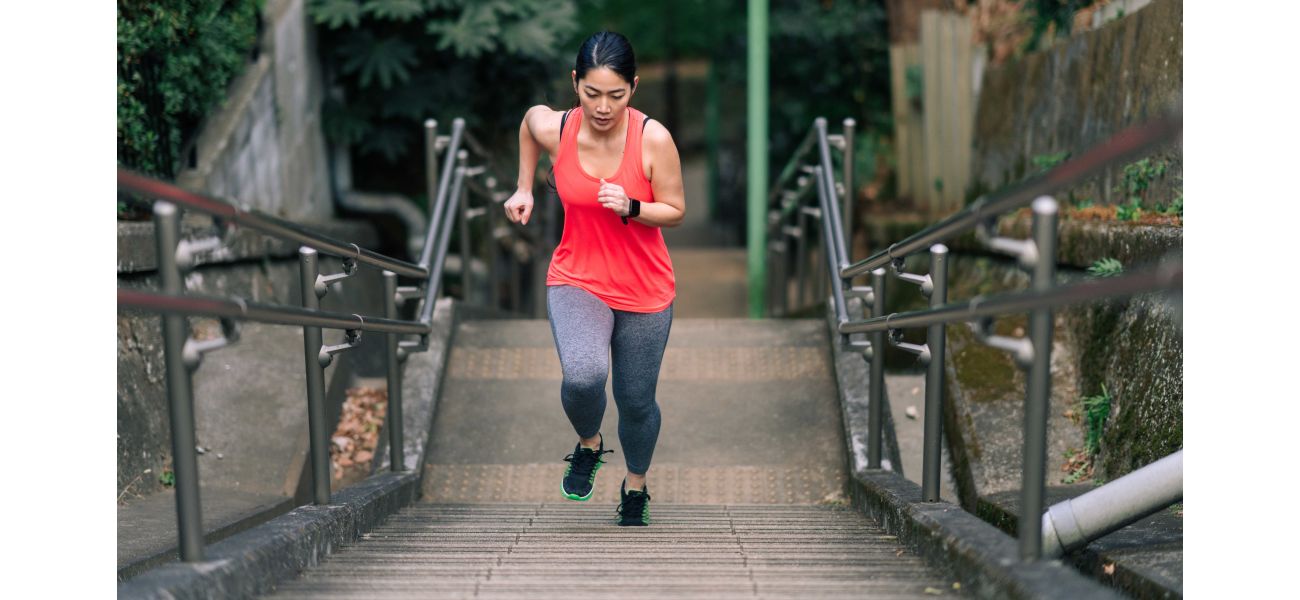Climbing stairs could be the best way to burn calories!
Stair climbing = quick fitness + calorie burn, per research.
September 22nd 2024.

If you're looking to shed some pounds and are searching for a new and effective method, consider incorporating stair-climbing into your regular routine. Not only is it easily accessible, but studies have shown that it is more efficient than walking on a flat surface.
Lauri van Houten, the vice president of the International Skyrunning Federation, which oversees various activities involving vertical climbing, explains, "Overall, it is a proven fact that stair-climbing results in quicker fitness gains and burns more calories." This includes disciplines such as mountain running above 2,000 meters and events like the Stairclimbing World Championships.
While these competitions are geared towards highly fit individuals, incorporating a few minutes of stair-climbing into your daily routine can have significant benefits for people of all ages. Van Houten adds, "The first question people often have is, 'How many calories will I burn?' Well, the good news is that the amount of energy expended during the exercise is dependent on your weight. So, the heavier you are, the more calories you will burn."
Stair-climbing is a fast and efficient way to burn calories. Research shows that going up stairs burns approximately 20 times more calories than walking on a flat surface, and even going down stairs burns around five times more due to the muscles used to slow the body's descent.
Dr. Alberto Minetti, a physiologist and biomechanist at the University of Milan, has extensively studied human locomotion, including stair-climbing. He notes, "It is an exercise that anyone can do. There are always stairs nearby, and it's free compared to a gym membership." Minetti also explains the math behind the effectiveness of stair-climbing, saying, "To move one kilogram of body mass over one horizontal meter, you expend 0.5 calories. But when moving the body vertically on stairs, it's 10 calories. That's 20 times the calories burned compared to moving horizontally."
For those who may be concerned about their age or fitness level, Minetti recommends being mindful of your speed and taking breaks if needed. As for adding stairs to his own fitness routine, Minetti does so by climbing the stairs to his third-floor apartment in Milan. He also suggests taking a few deep breaths before ascending to feel more refreshed at the top.
In a scientific study, Minetti also highlights the benefit of using handrails while climbing stairs, as it engages the arm muscles and increases the mechanical and metabolic power of the ascent. He adds, "Although the arm muscles are relatively small, they are better than nothing."
Stairs are everywhere, making stair-climbing a convenient and time-efficient exercise. From one or two flights at home to the stairwells of skyscrapers, stadiums, and office buildings, stairs can be easily incorporated into daily routines. Australian Suzy Walsham, a top stair-climbing athlete, has won numerous races, including five climbs up the Eiffel Tower and 10 races up the Empire State Building's 1,576 stairs.
But stair-climbing isn't just for elite athletes. Walsham notes, "You get a lot of benefits for a small amount of effort. As we age, running can become more challenging on our joints, but stair-climbing provides a low-impact alternative." Plus, it helps improve balance and can easily be worked into daily routines by simply choosing the stairs over escalators or elevators.
Yuri Yoshizumi, the women's division winner of last year's Stairclimbing World Championships in Osaka, Japan, also advocates for stair-climbing, saying, "It's an accessible sport for beginners and the general public. Elite athletes may push themselves harder, but it's a great way to strengthen your muscles and cardiovascular system in a short amount of time." She also notes that living in a large city, you can easily incorporate stair-climbing into your daily routine by opting for stairs instead of escalators at train stations and department stores.
Lauri van Houten, the vice president of the International Skyrunning Federation, which oversees various activities involving vertical climbing, explains, "Overall, it is a proven fact that stair-climbing results in quicker fitness gains and burns more calories." This includes disciplines such as mountain running above 2,000 meters and events like the Stairclimbing World Championships.
While these competitions are geared towards highly fit individuals, incorporating a few minutes of stair-climbing into your daily routine can have significant benefits for people of all ages. Van Houten adds, "The first question people often have is, 'How many calories will I burn?' Well, the good news is that the amount of energy expended during the exercise is dependent on your weight. So, the heavier you are, the more calories you will burn."
Stair-climbing is a fast and efficient way to burn calories. Research shows that going up stairs burns approximately 20 times more calories than walking on a flat surface, and even going down stairs burns around five times more due to the muscles used to slow the body's descent.
Dr. Alberto Minetti, a physiologist and biomechanist at the University of Milan, has extensively studied human locomotion, including stair-climbing. He notes, "It is an exercise that anyone can do. There are always stairs nearby, and it's free compared to a gym membership." Minetti also explains the math behind the effectiveness of stair-climbing, saying, "To move one kilogram of body mass over one horizontal meter, you expend 0.5 calories. But when moving the body vertically on stairs, it's 10 calories. That's 20 times the calories burned compared to moving horizontally."
For those who may be concerned about their age or fitness level, Minetti recommends being mindful of your speed and taking breaks if needed. As for adding stairs to his own fitness routine, Minetti does so by climbing the stairs to his third-floor apartment in Milan. He also suggests taking a few deep breaths before ascending to feel more refreshed at the top.
In a scientific study, Minetti also highlights the benefit of using handrails while climbing stairs, as it engages the arm muscles and increases the mechanical and metabolic power of the ascent. He adds, "Although the arm muscles are relatively small, they are better than nothing."
Stairs are everywhere, making stair-climbing a convenient and time-efficient exercise. From one or two flights at home to the stairwells of skyscrapers, stadiums, and office buildings, stairs can be easily incorporated into daily routines. Australian Suzy Walsham, a top stair-climbing athlete, has won numerous races, including five climbs up the Eiffel Tower and 10 races up the Empire State Building's 1,576 stairs.
But stair-climbing isn't just for elite athletes. Walsham notes, "You get a lot of benefits for a small amount of effort. As we age, running can become more challenging on our joints, but stair-climbing provides a low-impact alternative." Plus, it helps improve balance and can easily be worked into daily routines by simply choosing the stairs over escalators or elevators.
Yuri Yoshizumi, the women's division winner of last year's Stairclimbing World Championships in Osaka, Japan, also advocates for stair-climbing, saying, "It's an accessible sport for beginners and the general public. Elite athletes may push themselves harder, but it's a great way to strengthen your muscles and cardiovascular system in a short amount of time." She also notes that living in a large city, you can easily incorporate stair-climbing into your daily routine by opting for stairs instead of escalators at train stations and department stores.
[This article has been trending online recently and has been generated with AI. Your feed is customized.]
[Generative AI is experimental.]
0
0
Submit Comment





